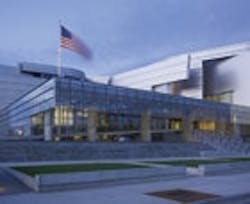Top 10 LEED Projects
By Robert Nieminen & Jamie Nicpon
Since it was introduced in 2000, the U.S. Green Building Council's LEED® (Leadership in Energy and Environmental Design) Green Building Rating SystemTM has served as a catalyst for the green building movement and provided a road map on how to get to a more sustainable built environment.
As a nationally accepted benchmark for green building design and construction, USGBC describes LEED as "a voluntary standards and certification program that defines high-performance green buildings." The system encompasses all building types including New Construction, Existing Buildings, Commercial Interiors, Core & Shell, Homes, and Neighborhoods.
LEED promotes a whole-building approach to sustainability by recognizing performance in five key areas of human and environmental health: sustainable site development; water savings; energy efficiency; materials selection; and indoor environmental quality. Within these five areas, points are available, and the number of points a project earns determines the level of certification that will be awarded: Certified, Silver, Gold or Platinum.
With more than 1,000 certified buildings and the amount of registered buildings exceeding 7,300, LEED has become the leading green building rating system in the United States. Some statistics to underscore this point include the fact that currently 1.1 billion square feet of commercial building space is registered or certified under the LEED Rating System; and there are now LEED projects in all 50 states and in 24 countries around the globe. Additionally, more than 38,000 design practitioners have passed the LEED Accreditation exam since the program was launched in 2001.
Utilizing feedback from its members and users, USGBC is also taking steps to evolve the LEED system, making it more flexible and adaptive while maintaining its technical stringency and consensus-based integrity.
"Taking LEED to the next level involves the investment of time, expertise and dedication from USGBC's richly diverse membership," notes Rick Fedrizzi, president, CEO & founding chair, USGBC. "But we're confident the elegant framework envisioned for LEED responds to marketplace needs, while keeping intact both the creativity and the technical rigor that are LEED's hallmarks."
The following links showcase 10 recent LEED projects that demonstrate the ability and versatility of the rating system to forever alter the landscape of the built environment ... creating truly great places to live, work, learn,
heal and play.
